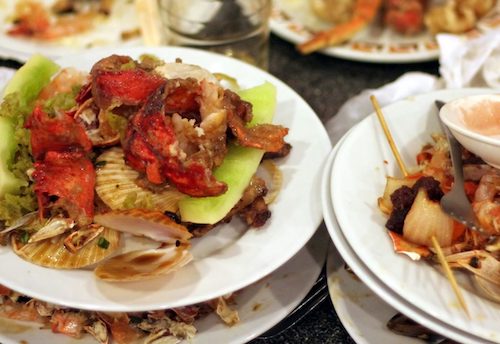Food waste is a huge problem across the world.
The EPA estimates that more food reaches incinerators and landfills than any other single material in our everyday trash, constituting a whopping 22 percent of discarded municipal waste.
Food waste rattles restaurants badly, with businesses literally throwing away billions of dollars of potential profits in the trash. The restaurant industry is an unfortunate contributor to this issue.
A study by Food Waste Reduction Alliance (FWRA) reported that 84.3% of untouched food in restaurants ends up in the trash. However, there’s hope that restaurants can take action to reduce their food waste in ways that will have positive effects on the environment, their customers, their employees and their profit margins. Since food costs almost 35% of restaurant sales, dealing with food waste can make a substantial difference.
Let’s dig into some ways that restaurants can reduce food waste:
1. Conduct a waste audit
The first step to reduce waste is to find out how much is being wasted, and what kind of waste is being produced. By conducting a waste audit, you can find out how much your restaurant is currently throwing away and what the potential cost savings are. The primary goal of this audit is to identify where your restaurant’s waste comes from, so you can pinpoint ways to reduce it. Be warned, things might get a little messy – this method requires you to roll slap on some gloves and dig through the trash. Here’s how it works – every day for a week, open up the bags and separate the trash into these categories:
- Produce (vegetables, fruit)
- Meat (red meat, poultry, fish)
- Takeout products (plates, containers, cups, etc.)
- Paper products (napkins, flyers, paper towels, receipts, etc.)
- Plastics, other (broken crockery, aluminium foil, glass)
Once every piece of trash has been sorted, weigh each of the piles on a scale and jot down their weights in a spreadsheet. Then, multiply the weight from each category by the number of days your restaurant is open per year, which will give you a rough estimation of your annual waste. Now that you’ve done the dirty work, it’s time to analyse your waste results. The categories with the heaviest weights require your most immediate attention. For example, if you find that your produce waste is heavy, it could be an indication that you’re not purchasing the freshest options from your distributors, or that your customers aren’t crazy about your seasonal menu offerings. A waste audit will show you exactly what changes you need to make, and that insight will be powerful for how you manage your operations in the future.
2. Fine-tune your menu
You can create less food waste by offering fewer menu options – and only keeping the most popular dishes. Use an inventory to help you figure out what items aren’t selling as well as others so you can make choices on what to pare down. Besides, too many menu options can actually confuse customers. You can also find ways to use the same ingredients in several dishes across the menu, which will help you save money by purchasing food items in bulk and reduce the DOH (days on hand) ratio of the item. Not to mention, you’ll cut down on food waste since the inventory is less likely to spoil. For example, if you only use eggplant in one appetiser recipe, consider adding it to other menu offerings such as pizza or pasta dishes instead of letting unused stock go bad.
3. Train staff to waste less
When reducing restaurant food waste, the whole staff needs to be on board. Keep employees in the know about ways to reduce food waste, and teach them strategies they can easily implement in their roles. Educate prep cooks about cutting techniques that yield the most amount of product and how to keep food items fresher for longer. Double down on the refrigerator labelling process and teach kitchen staff how to store items properly. If there’s a team mentality about reducing food waste and everyone feels involved, there’s a greater chance of success.
You can also adopt the first-in/first-out method (FIFO) in your kitchen to reduce the amount of spoilage in your restaurant. In a FIFO kitchen, inventory will be organised and used in the order they arrive on-site, meaning the oldest food items are used first. For example, if you receive a shipment of carrots on Monday and again on Thursday, the carrots that arrived on Monday will be used in kitchen prep first. This ensures no perfectly good product goes to waste simply because of the order of delivery.
4. Recycle and implement reusable items
If your restaurant isn’t recycling by now, it’s time to get on board (it’s 2020!) Divert used glass and cardboard to dedicated recycling bins and encourage employees to be careful about separating recyclable materials from landfill waste. Contact your local waste management company to start a recycling program if you haven’t already. Try figuring out what items in your restaurant can be cleaned and reused. You can swap out paper napkins for cloth ones or commit to using silverware instead of plasticware. Stop offering straws altogether, use paper ones, or even consider pasta straws. You can extend this idea to customers, too. Try encouraging customers placing takeout orders to bring their own containers, and offer a small discount in return.
5. Start composting
For the food waste you do end up with, composting is an excellent way to divert food waste from the landfill. Many countries today offer composting programs to prevent food scraps from decomposing in landfills and generating methane. It’s certainly an eco-friendly option for taking care of leftover food scraps on diner’s plates.
6. Buy locally
Support your hard-working local farmers and producers and cut down on time between harvest and delivery. The popularity of “farm to table” has exploded in the past few years as restaurant owners and consumers enjoy getting fresher food from more trustworthy sources. Buying locally reduces the number of phases fresh foods go through, which, in turn, reduces restaurant waste because items stay fresher for longer.
7. Create in-house preservation strategies
Even if you adopt a streamlined waste and inventory management plan, some amount of food is still going to end up not getting used. You can accept the items as waste, or get creative and learn how to preserve these items and give them a second life.
Pickling is one of the oldest preservation techniques and can easily turn wilting produce into Giardiniera for a sandwich special, or Kimchi for a rice bowl. Carrot tops and beet greens that would normally be tossed can be turned into a pesto and frozen for future use in pasta or fish dishes. The key is to always be thinking of ways you can save trimmings and extraneous items from the trash for use in creative dishes.
8. Calculate and monitor inventory days on hand
Inventory days on hand, or DOH, is an accounting ratio that refers to the average number of days you hold inventory before it is sold. You can calculate DOH by dividing the average inventory for a specific period by the corresponding cost of goods sold for that same period, and multiply the result by 365. Pay attention to which food items have higher inventory days on hand. That item might not be selling quickly because customers aren’t ordering that particular dish, and a menu adjustment may be necessary.
Additionally, food items that have lower inventory days on hand are selling like hotcakes – use this information to modify your vendor orders to only include what you’ll reliably use in between deliveries. Be sure to frequently revisit these DOH reports to ensure you’re staying current on what’s selling, what’s not, and what costs have changed due to market trends and seasonality.
9. Use inventory tracking technology
Restaurant inventory managements systems are your secret weapon when it comes to staying on top of inventory tracking. These platforms help you strategise what items to order to cut down on waste, while helping you control your budget and spending. The right tech solution can provide actionable data into how you’re actually performing financially. You can use them to calculate food cost percentage, reduce over-buying, and figure out your least and most profitable items. You’ll receive reports on inventory that goes out, such as menu items and ingredients sold and waste produced. This technology keeps you up to date on daily waste production, so you can create strategies to reduce it.
10. Start with small changes
The journey to waste reduction requires dedication, a team effort, and time. Implementing small changes to reduce food waste each month will amount to a substantial difference by the end of the year.
Try setting monthly goals that touch on one or two of these key strategies, and you’ll likely see less waste – and hopefully an increase to your bottom line.
By Stephanie R
Christ & Co.













